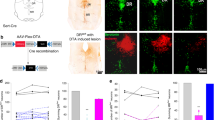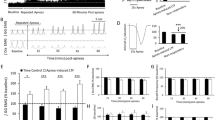Abstract
Spinal afferents such as nociceptive afferents and group III–IV muscle afferents are known to exert an acute excitatory effect on breathing when activated. Here, we report the surprising existence of latent spinal afferents which exerted tonic inhibitory influence on breathing subliminally in anesthetized rats, an effect which was reversed upon activation of serotonin-1A receptors (5-HT1ARs) in lumbar spinal cord, lesion of pontine lateral parabrachial nucleus or suppression of the adjacent Kölliker-Fuse nucleus with NMDA receptor blockade. Small-interfering RNA knockdown of 5-HT1ARs in lumbar spinal cord unequivocally localized the site of 5-HT1AR-mediated gating of these respiratory-inhibiting interoceptive afferents to relay neurons in the spinal superficial dorsal horn at the lumbar level and not cervical spinal or supraspinal levels. Our results reveal a novel somatosensory/viscerosensory mechanism which exerts tonic inhibitory influence on homeostatic regulation of breathing independent from the classical chemoreflex excitatory pathways, and suggest a hitherto unrecognized therapeutic target in spinal dorsal horn for 5-HT1AR-based treatment of a variety of respiratory abnormalities.



Similar content being viewed by others
References
Abdala AP, Dutschmann M, Bissonnette JM, Paton JF (2010) Correction of respiratory disorders in a mouse model of Rett syndrome. Proc Natl Acad Sci USA 107:18208–18213
Audero E, Coppi E, Mlinar B, Rossetti T, Caprioli A, Banchaabouchi MA, Corradetti R, Gross C (2008) Sporadic autonomic dysregulation and death associated with excessive serotonin autoinhibition. Science 321:130–133
Bernard JF, Huang GF, Besson JM (1994) The parabrachial area: electrophysiological evidence for an involvement in visceral nociceptive processes. J Neurophysiol 71:1646–1660
Boden AG, Harris MC, Parkes MJ (1998) Apneic threshold for CO2 in the anesthetized rat: fundamental properties under steady-state conditions. J Appl Physiol 85:898–907
Cechetto DF, Standaert DG, Saper CB (1985) Spinal and trigeminal dorsal horn projections to the parabrachial nucleus in the rat. J Comp Neurol 240:153–160
Celada P, Bortolozzi A, Artigas F (2013) Serotonin 5-HT1A receptors as targets for agents to treat psychiatric disorders: rationale and current status of research. CNS Drugs 27:703–716
Cervero F, Laird JM (1999) Visceral pain. Lancet 353:2145–2148
Choi H, Liao WL, Newton KM, Onario RC, King AM, Desilets FC, Woodard EJ, Eichler ME, Frontera WR, Sabharwal S, Teng YD (2005) Respiratory abnormalities resulting from midcervical spinal cord injury and their reversal by serotonin 1A agonists in conscious rats. J Neurosci 25:4550–4559
Clapham DE (2003) TRP channels as cellular sensors. Nature 426:517–524
Colpaert FC (2006) 5-HT(1A) receptor activation: new molecular and neuroadaptive mechanisms of pain relief. Curr Opin Investig Drugs 7:40–47
Corcoran AE, Commons KG, Wu Y, Smith JC, Harris MB, Richerson GB (2014) Dual effects of 5-HT(1a) receptor activation on breathing in neonatal mice. J Neurosci 34:51–59
Craig AD (2002) How do you feel? Interoception: the sense of the physiological condition of the body. Nat Rev Neurosci 3:655–666
Craig AD (2003) Interoception: the sense of the physiological condition of the body. Curr Opin Neurobiol 13:500–505
Craig AD (2015) How do you feel? An interoceptive moment with your neurobiological self
Craig AD, Bushnell MC, Zhang ET, Blomqvist A (1994) A thalamic nucleus specific for pain and temperature sensation. Nature 372:770–773
Duncan JR, Paterson DS, Hoffman JM, Mokler DJ, Borenstein NS, Belliveau RA, Krous HF, Haas EA, Stanley C, Nattie EE, Trachtenberg FL, Kinney HC (2010) Brainstem serotonergic deficiency in sudden infant death syndrome. JAMA 303:430–437
Dutschmann M, Dick TE (2012) Pontine mechanisms of respiratory control. Compr Physiol 2:2443–2469
El-Khatib MF, Kiwan RA, Jamaleddine GW (2003) Buspirone treatment for apneustic breathing in brain stem infarct. Respir Care 48:956–958
Feil K, Herbert H (1995) Topographic organization of spinal and trigeminal somatosensory pathways to the rat parabrachial and Kolliker-Fuse nuclei. J Comp Neurol 353:506–528
Fiorino F, Severino B, Magli E, Ciano A, Caliendo G, Santagada V, Frecentese F, Perissutti E (2014) 5-HT(1A) receptor: an old target as a new attractive tool in drug discovery from central nervous system to cancer. J Med Chem 57:4407–4426
Gauriau C, Bernard JF (2002) Pain pathways and parabrachial circuits in the rat. Exp Physiol 87:251–258
Giraudin A, Le Bon-Jego M, Cabirol MJ, Simmers J, Morin D (2012) Spinal and pontine relay pathways mediating respiratory rhythm entrainment by limb proprioceptive inputs in the neonatal rat. J Neurosci 32:11841–11853
Hylden JL, Anton F, Nahin RL (1989) Spinal lamina I projection neurons in the rat: collateral innervation of parabrachial area and thalamus. Neuroscience 28:27–37
Jankowski MP, Rau KK, Ekmann KM, Anderson CE, Koerber HR (2013) Comprehensive phenotyping of group III and IV muscle afferents in mouse. J Neurophysiol 109:2374–2381
Jeong HJ, Mitchell VA, Vaughan CW (2012) Role of 5-HT(1) receptor subtypes in the modulation of pain and synaptic transmission in rat spinal superficial dorsal horn. Br J Pharmacol 165:1956–1965
Jiang M, Alheid GF, Calandriello T, McCrimmon DR (2004) Parabrachial-lateral pontine neurons link nociception and breathing. Respir Physiol Neurobiol 143:215–233
Kayalioglu G (2009) Projections from the spinal cord to the brain. In: Watson C, Paxinos G, Kayalioglu G (eds) Spinal cord: A Christopher and Dana Reeve Foundation Text and Atlas. Elsevier/Academic Press, Amsterdam, pp 148–167
Kumar P, Prabhakar NR (2012) Peripheral chemoreceptors: function and plasticity of the carotid body. Compr Physiol 2:141–219
Lacivita E, Di Pilato P, De Giorgio P, Colabufo NA, Berardi F, Perrone R, Leopoldo M (2012) The therapeutic potential of 5-HT1A receptors: a patent review. Expert Opin Ther Pat 22:887–902
Lalley PM, Bischoff AM, Richter DW (1994) Serotonin 1A-receptor activation suppresses respiratory apneusis in the cat. Neurosci Lett 172:59–62
Lara JP, Parkes MJ, Silva-Carvhalo L, Izzo P, Dawid-Milner MS, Spyer KM (1994) Cardiovascular and respiratory effects of stimulation of cell bodies of the parabrachial nuclei in the anaesthetized rat. J Physiol 477(Pt 2):321–329
Lu Y, Perl ER (2007) Selective action of noradrenaline and serotonin on neurones of the spinal superficial dorsal horn in the rat. J Physiol 582:127–136
Manzke T, Dutschmann M, Schlaf G, Morschel M, Koch UR, Ponimaskin E, Bidon O, Lalley PM, Richter DW (2009) Serotonin targets inhibitory synapses to induce modulation of network functions. Philos Trans R Soc Lond B Biol Sci 364:2589–2602
Manzke T, Niebert M, Koch UR, Caley A, Vogelgesang S, Hulsmann S, Ponimaskin E, Muller U, Smart TG, Harvey RJ, Richter DW (2010) Serotonin receptor 1A-modulated phosphorylation of glycine receptor alpha3 controls breathing in mice. J Clin Invest 120:4118–4128
Marlier L, Teilhac JR, Cerruti C, Privat A (1991) Autoradiographic mapping of 5-HT1, 5-HT1A, 5-HT1B and 5-HT2 receptors in the rat spinal cord. Brain Res 550:15–23
Mizusawa A, Ogawa H, Kikuchi Y, Hida W, Shirato K (1995) Role of the parabrachial nucleus in ventilatory responses of awake rats. J Physiol 489(Pt 3):877–884
Mulkey DK, Stornetta RL, Weston MC, Simmons JR, Parker A, Bayliss DA, Guyenet PG (2004) Respiratory control by ventral surface chemoreceptor neurons in rats. Nat Neurosci 7:1360–1369
Nakamura K, Morrison SF (2008) A thermosensory pathway that controls body temperature. Nat Neurosci 11:62–71
Nakamura K, Morrison SF (2010) A thermosensory pathway mediating heat-defense responses. Proc Natl Acad Sci USA 107:8848–8853
Paxinos G, Watson C (2007) The rat brain in stereotaxic coordinates, 6th edn. Elsevier, Amsterdam
Poon CS (2009) Optimal interaction of respiratory and thermal regulation at rest and during exercise: role of a serotonin-gated spinoparabrachial thermoafferent pathway. Respir Physiol Neurobiol 169:234–242
Poon CS, Song G (2015) Type III–IV muscle afferents are not required for steady-state exercise hyperpnea in healthy subjects and patients with COPD or heart failure. Respir Physiol Neurobiol 216:78–85
Potts JT, Rybak IA, Paton JF (2005) Respiratory rhythm entrainment by somatic afferent stimulation. J Neurosci 25:1965–1978
Sahibzada N, Ferreira M, Wasserman AM, Taveira-DaSilva AM, Gillis RA (2000) Reversal of morphine-induced apnea in the anesthetized rat by drugs that activate 5-hydroxytryptamine(1A) receptors. J Pharmacol Exp Ther 292:704–713
Song G, Poon CS (2009a) Lateral parabrachial nucleus mediates shortening of expiration during hypoxia. Respir Physiol Neurobiol 165:1–8
Song G, Poon CS (2009b) Lateral parabrachial nucleus mediates shortening of expiration and increase of inspiratory drive during hypercapnia. Respir Physiol Neurobiol 165:9–12
Song E, Lee SK, Wang J, Ince N, Ouyang N, Min J, Chen J, Shankar P, Lieberman J (2003) RNA interference targeting Fas protects mice from fulminant hepatitis. Nat Med 9:347–351
Song G, Yu Y, Poon CS (2006) Cytoarchitecture of pneumotaxic integration of respiratory and nonrespiratory information in the rat. J Neurosci 26:300–310
Song G, Tin C, Poon CS (2015) Multiscale fingerprinting of neuronal functional connectivity. Brain Struct Funct 220:2967–2982
Tan PH, Yang LC, Shih HC, Lan KC, Cheng JT (2005) Gene knockdown with intrathecal siRNA of NMDA receptor NR2B subunit reduces formalin-induced nociception in the rat. Gene Ther 12:59–66
Teng YD, Bingaman M, Taveira-DaSilva AM, Pace PP, Gillis RA, Wrathall JR (2003) Serotonin 1A receptor agonists reverse respiratory abnormalities in spinal cord-injured rats. J Neurosci 23:4182–4189
Thor KB, Nickolaus S, Helke CJ (1993) Autoradiographic localization of 5-hydroxytryptamine1A, 5-hydroxytryptamine1B and 5-hydroxytryptamine1C/2 binding sites in the rat spinal cord. Neuroscience 55:235–252
Todd AJ (2010) Neuronal circuitry for pain processing in the dorsal horn. Nat Rev Neurosci 11:823–836
Wilken B, Lalley P, Bischoff AM, Christen HJ, Behnke J, Hanefeld F, Richter DW (1997) Treatment of apneustic respiratory disturbance with a serotonin-receptor agonist. J Pediatr 130:89–94
Williams MC, Ivanusic JJ (2008) Evidence for the involvement of the spinoparabrachial pathway, but not the spinothalamic tract or post-synaptic dorsal column, in acute bone nociception. Neurosci Lett 443:246–250
Wilson LB, Andrew D, Craig AD (2002) Activation of spinobulbar lamina I neurons by static muscle contraction. J Neurophysiol 87:1641–1645
Yaksh TL, Rudy TA (1976) Chronic catheterization of the spinal subarachnoid space. Physiol Behav 17:1031–1036
Yoshimura M, Furue H (2006) Mechanisms for the anti-nociceptive actions of the descending noradrenergic and serotonergic systems in the spinal cord. J Pharmacol Sci 101:107–117
Yoshida A, Chen K, Moritani M, Yabuta NH, Nagase Y, Takemura M, Shigenaga YJ (1997) Organization of the descending projections from the parabrachial nucleus to the trigeminal sensory nuclear complex and spinal dorsal horn in the rat. J Comp Neurol 383(1):94–111
Zhuang J, Zhang Z, Zhang C, Xu F (2012) 8-OH-DPAT abolishes the pulmonary C-fiber-mediated apneic response to fentanyl largely via acting on 5HT1A receptors in the nucleus tractus solitarius. Am J Physiol Regul Integr Comp Physiol 303:R449–R458
Zimmer MB, Goshgarian HG (2006) Spinal activation of serotonin 1A receptors enhances latent respiratory activity after spinal cord injury. J Spinal Cord Med 29:147–155
Acknowledgments
This work was supported by National Institutes of Health Grants HL093225 and HL067966.
Author information
Authors and Affiliations
Corresponding author
Additional information
L. Yang and G. Song contributed equally to this work.
Rights and permissions
About this article
Cite this article
Yang, L., Song, G., Ning, Y. et al. A latent serotonin-1A receptor-gated spinal afferent pathway inhibiting breathing. Brain Struct Funct 221, 4159–4168 (2016). https://doi.org/10.1007/s00429-015-1155-z
Received:
Accepted:
Published:
Issue Date:
DOI: https://doi.org/10.1007/s00429-015-1155-z




